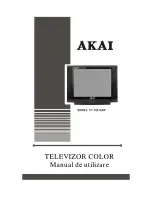
CC2500
SWRS040C
Page 37 of 89
17.5
Clear Channel Assessment (CCA)
The Clear Channel Assessment CCA) is used
to indicate if the current channel is free or
busy. The current CCA state is viewable on
any of the
GDO
pins by setting
=0x09.
selects the mode to use
when determining CCA.
When the
or
command strobe is
given while
CC2500
is in the RX state, the TX
or FSTXON state is only entered if the clear
channel requirements are fulfilled. The chip
will otherwise remain in RX (if the channel
becomes available, the radio will not enter TX
or
FSTXON
state
before
a
new
strobe
command is sent on the SPI interface). This
feature
is
called
TX-if-CCA.
Four
CCA
requirements can be programmed: Four CCA
requirements can be programmed:
Always (CCA disabled, always goes to TX)
If RSSI is below threshold
Unless currently receiving a packet
Both the above (RSSI below threshold and
not currently receiving a packet)
17.6
Link Quality Indicator (LQI)
The Link Quality Indicator is a metric of the
current quality of the received signal. If
is enabled, the
value is automatically added to the last byte
appended after the payload. The value can
also be read from the
status register. The
LQI gives an estimate of how easily a received
signal can be demodulated by accumulating
the magnitude of the error between ideal
constellations and the received signal over the
64 symbols immediately following the sync
word.
LQI
is
best
used
as
a
relative
measurement of the link quality (a high value
indicates a better link than what a low value
does), since the value is dependent on the
modulation format.
18 Forward Error Correction with Interleaving
18.1
Forward Error Correction (FEC)
CC2500
has built in support for Forward Error
Correction (FEC). To enable this option, set
to 1. FEC is only supported
in
fixed
packet
length
mode
(
).
FEC
is
employed on the data field and CRC word in
order to reduce the gross bit error rate when
operating
near
the
sensitivity
limit.
Redundancy is added to the transmitted data
in such a way that the receiver can restore the
original data in the presence of some bit
errors.
The use of FEC allows correct reception at a
lower SNR, thus extending communication
range. Alternatively, for a given SNR, using
FEC decreases the bit error rate (BER). As the
packet error rate (PER) is related to BER by:
length
packet
BER
PER
_
)
1
(
1
a lower BER can be used to allow longer
packets, or a higher percentage of packets of
a given length, to be transmitted successfully.
Finally, in realistic ISM radio environments,
transient and time-varying phenomena will
produce occasional errors even in otherwise
good reception conditions. FEC will mask such
errors and, combined with interleaving of the
coded
data,
even
correct
relatively
long
periods of faulty reception (burst errors).
The FEC scheme adopted for
CC2500
is
convolutional coding, in which
n
bits are
generated based on
k
input bits and the
m
most recent input bits, forming a code stream
able to withstand a certain number of bit errors
between each coding state (the
m
-bit window).
The convolutional coder is a rate 1/2 code with
a constraint length of m=4. The coder codes
one input bit and produces two output bits;
hence, the effective data rate is halved. I.e. to
transmit at the same effective data rate when
using FEC, it is necessary to use twice as high
over-the-air data rate. This will require a higher
receiver
bandwidth,
and
thus
reduce
sensitivity.
In other
words,
the
improved
reception by using FEC and the degraded
sensitivity from a higher receiver bandwidth
will be counteracting factors.
18.2
Interleaving
Data received through radio channels will
often
experience
burst
errors
due
to
Summary of Contents for CC2500
Page 91: ...PACKAGE OPTION ADDENDUM www ti com 6 Feb 2020 Addendum Page 2 ...
Page 94: ......
Page 95: ......
















































